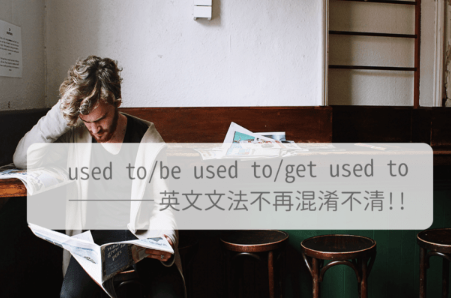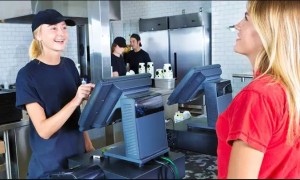(1). Used to + 原形动词
表示过去经常做的事,但现在不做了。用在过去式来表示过去的事实,有今昔相 比的意涵。
*to为不定词后面+原形动词 ; used to 为助动词
肯定句: He used to cook at home. 他过去经常在家煮饭
否定句/疑问句: 可视used to 为助动词或动词使用
助动词 *较少用,多为论文正式用法
He used not to cook at home
Used he to cook at home.
动词
He didn’t used to cook at home.
Did he used to cook at home?
Would V.S. Used to
大家常将would 与 used to 替换着使用,其实两者在意思上略有不同。
– Would 表过去习惯,较着墨于过去的状态,仅叙述过去不断重复的动作或情况,常与频率副词一起使用。
– used to 则表示过去与现在的不同,有过去与现在相互对照的概念,叙述在过去持续一段时间的动作或情况,且包括不断重复的动作或情况。

例子 (1):
When I was at home, I used to/would cook every weekend. (每当我在家,我习惯在周末时烹调。)
*cook every weekend,这是重复许多次的动作,因此两者可以替换使用。
例子 (2):
He used to live in Taichung until he was 18 years old. (他住在台中直到他18岁。)
*住在台中不是重复性动作,不会反覆住,因此两者不能替代
※因此若为重复动作,两者可以替代;若表示过去现在状况不同,则用used to
(2).Be used to +Ving/N.
表示对某事感到习惯或熟悉,用于现在式或过去式(少用)
*used是形容词; to是介系词后面+动名词或名词
肯定句: I am used to drinking coffee in the morning. (我习惯在早上喝咖啡。)
※虽然 be used to 可以用在过去和现在式,但是用在过去式时跟used to 但意涵一样,故通常在过去式时会使用used to + 原形动词
※在被动语态时,有另一种用法:
物品+Be used to +原形动词: 物品被用来做某件事情。
*used是 use 的被动语态,而 to 是不定词后面加原型动词。
例子:Sunglasses are used to protect eyes from the sun’s damaging ultraviolet (UV) rays. (太阳眼镜用来保护眼睛受到太阳的紫外线。)
(3). Get used to +Ving/N.
表从不习惯转为习惯,开始习惯某事。常用于过去和未来,与Be used to +Ving/N.用法相似
肯定句: After a while, Andy got used to living on his own. ( 一段时间后,安迪习惯了自己过生活。必须习惯自己过生活。)
(4). 秘笈包
针对这种相似又常考的片语,最简单的方法就是以自身经验造一个例子,现在公开小编的方法:
I used to get up early. (我过去经常早起,但现在没有。)
I am used to staying up late. (我习惯熬夜。)
The cell phone is used to connect other people. (手机用来联络他人。)
I get used to the graduate life. (我开始习惯研究所生活。)







